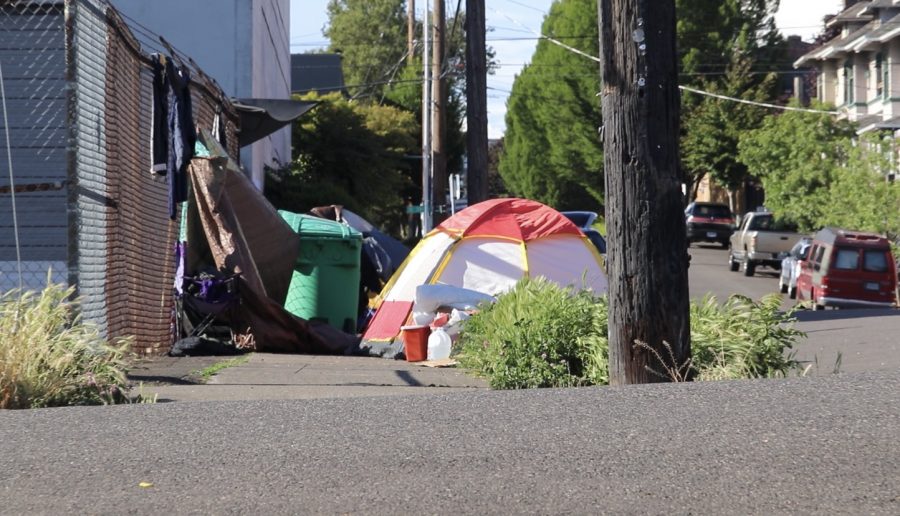Homelessness in Portland Is a Huge Problem — Here Is What We Can Do
May 29, 2019
Oregon is ranked second in the U.S. for the amount of unsheltered homeless, people who are without a permanent place to live and escape the weather. For homeless people in Multnomah County, the count climbed 10% in just two years to a total of 4,177 in 2017.
This recent increase in the homeless population shows that this issue will not just go away, especially if we stand by and do nothing.
Fortunately, there are things that can be done to eliminate or at least slow down this increase.
The biggest issue is the fact that many homeless people are chronically homeless. People classified as chronically homeless are those who use shelters as long term housing rather than in emergencies. They often suffer from disabilities and/or substance abuse problems.
31% of the homeless population in Portland is considered chronically homeless. Finding a way to lessen the number or severity of this homelessness is key to reducing homelessness and its effects on people and society.
One solution that is gaining popularity is the Housing First method. The Housing First method is based on the idea that people are better able to move forward with their lives if they are first housed. With the stability provided by having housing, they are able to get their lives back on track easier than without a house.
This method concentrates on moving homeless into independent and permanent housing and is not contingent on demonstrating that they are “ready” for housing (with regard to sobriety, income, mental health, etc.). By living in permanent housing, it allows them to no longer be considered homeless.
The Housing First method does more than just provide housing; it also provides additional support such as help finding jobs or further education, addiction recovery programs as well as clinical help for physical and mental issues, all of which are crucial to living healthy lives.
In Canada, the Housing First method has proved to be successful; a study of 1,000 people saw that 80% of people stayed in housing after the first year, while also relying less on public health services and law enforcement. If we could successfully implement this strategy in Portland, we would likely see a dramatic decrease in the homeless population. This would require a lot of money, but the severity of our current homelessness crisis demands urgent action.
For those wishing to learn more about the Housing First method, I highly recommend watching this Ted Talk by Juha Kaakinen.
The other two types of homelessness are transitional and episodic.
The transitionally homeless encompass people who generally use the shelters for a one time stay while they figure out other arrangements. Transitionally homeless individuals make up the majority of persons experiencing homelessness, because people are continually in and out of housing. This could be, in part, due to the fact that 40% of Americans cannot come up with $400 in the event of an emergency, a recent study found.
The episodic homeless are frequently in and out of shelters. Most of the episodic homeless are on the younger side and commonly experience medical, mental health, and substance abuse problems.
The issue of homelessness will always exist because people are continually in and out of living spaces. However, there are many things that can be done to mitigate this issue.
So far, the City of Portland has tried many things but has yet to find a long term solution that can permanently fix all three types of homelessness.
In 2010-2016, “about six new housing units were built for every ten additional households formed” in the Portland area during that period. These new units have begun to address the lack of sufficient housing in Portland, which has been one of the biggest factors in the increasing homeless community.
Another method that has been attempted is the Housing Choice Voucher (HCV). It is designed to lower housing costs for low-income households. This program aims to adjust rent payments to about 30% of the tenant’s income. Although this has helped to a degree, the income threshold for eligibility is too low for it to be a permanent solution for many families.
A long-standing “band-aid” for the issue has been emergency shelters. These shelters, while effective for short periods of time, are not a good permanent solution. There is no guarantee for homeless people that they will be granted access to these facilities. The homeless who are admitted into shelters are often confronted with a place that is crowded, noisy, and cannot necessarily provide safety for vulnerable populations such as women, children, and disabled adults.
These attempts at complete solutions done by the City of Portland and other government agencies do their best to provide aid for the two types of homelessness that will always exist.
Although the government has made these various efforts to curb homelessness, everyday citizens must also do their part, if we really want to end this epidemic.
Even though many of us see homelessness in our everyday lives, we might not know what we can do to help.
First, we can help raise awareness. Raising awareness can cause others to pay attention to the problem, and can lead to more research, volunteers, and overall help. Raising awareness would also put more pressure on the city to re-evaluate its budget to include more funds for the research and development of low-cost housing and other potential solutions.
As students, many of us do not have the time to volunteer as much as is needed. Even so, there are still things that can be done to help. We can volunteer a few hours of our time to work at hot meal programs, donate clothes and other necessities to homeless drives, and even just donate any amount of money to charities. Doing these things might not solve homelessness entirely, but will help improve the lives of those experiencing homelessness.
Since a long term solution has not been found, we need to devote more resources to research finding a solution. This means researching causes of homelessness, identifying specific populations that need the most support, and figuring out ways to build low-cost, sustainable housing that can be rented out for a lower-than-market price.
The best solution we have so far is the Housing First method. It has the best success rate and attacks the many issues that the homeless face, beyond just the obvious lack of housing. In order to continue and improve this solution, we can and should be willing to donate time, effort, and money to this cause. These solutions will definitely require money, which is a sacrifice that we should be prepared to make.
Ultimately, if we are able to eliminate homelessness, we will all see an improvement in our city’s cleanliness, health and overall standard of living. Beyond that, it is also just the right thing to do.
People experiencing homelessness are humans just like us and deserve the same unalienable rights that the Constitution gives us all. We should have no reservations about helping out our fellow Americans in times of need. We are able to; therefore, we should.






Caitlin Hudson • May 30, 2019 at 8:22 am
Thank you for writing on this important topic and proposing these solutions Ryan. Planet Money just put out a podcast about this topic that you or others who are interested in homelessness may find interesting: https://www.npr.org/2019/05/17/724462179/episode-913-counting-the-homeless